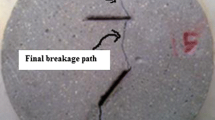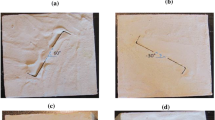Abstract
Crack propagation processes in specially prepared concrete discs and rectangular specimens containing a single cylindrical hole or multiple holes of varying diameters have been studied both experimentally and numerically. In this research, the cracks coalescence paths in Brazilian disc and rectangular specimens made from rock-like material containing multi-holes are investigated. These concrete specimens are specially prepared from an appropriate mixture of Portland Pozzolana Cement (PPC), fine sands, and water. The pre-holed Brazilian discs and rectangular specimens are experimentally tested under compression. The breakage load in the ring type disc specimens containing an axial hole with varying diameters is measured and the distribution of the induced lateral stress is obtained. The mechanism of cracks propagation in the wall of the ring type specimens is also studied. In the case of multi-hole Brazilian disc and rectangular specimens, the cracks propagation and cracks coalescence are also investigated. These experiments are numerically modeled by a modified higher order displacement discontinuity method. It has been shown that the corresponding experimental and numerical results are in good agreement with each other. The results presented in this research validate the accuracy and applicability of these crack analyses procedures.


















Similar content being viewed by others
References
Kato, T., Nishioka, T.: Analysis of micro-macro material properties and mechanical effects of damaged material containing periodically distributed elliptical microcracks. Int. J. Fract. 131, 247–266 (2005)
Hudson, J.A., Brown, E.T., Rummel, F.: Controlled failure of rock diss and rings loaded in diametral compression. Int. J. Rock Mech. Min. Sci. 9, 241–248 (1972)
Hudson, J.A.: Tensil strength and the Ring test. Int. J. Rock Mech. Min. Sci. 6, 91–97 (1969)
Sammis, C.G., Ashby, M.F.: The failure of brittle porous solids under compressive stress states. Acta. Metall. 34, 511–526 (1986)
Wong, R.H.C., Chau, K.T.: Crack coalescence in a rock-like material containing two cracks. Int. J. Rock Mech. Min. Sci. 35, 147–164 (1998)
Wong, R.H.C., Chau, K.T., Tang, C.A., et al.: Analysis of crack coalescence in rock-like materials containing three flaws—Part I: experimental approach. Int. J. Rock Mech. Min. Sci. 38, 909–924 (2001)
Wong, R.H.C., Tang, C.A., Chau, K.T., et al.: Splitting failure in brittle rocks containing pre-existing flaws under uniaxial compression. Eng. Fract. Mech. 69, 1853–1871 (2002)
Park, C.H.: Coalescence of Frictional Fractures in Rock Materials. PhD Thesis, Purdue University West Lafayette, Indiana (2008)
Yang, Q., Dai, Y.H., Han, L.J., et al.: Experimental study on mechanical behavior of brittle marble samples containing different flaws under uniaxial compression. Eng. Fract. Mech. 76, 1833–1845S (2009)
Park, C.H., Bobet, A.: Crack coalescence in specimens with open and closed flaws: a comparison. Int. J. Rock Mech. Min. Sci. 46, 819–829C (2009)
Park, C.H., Bobet, A.: Crack initiation, propagation and coalescence from frictional flaws in uniaxial compression. Eng. Fract. Mech. 77, 2727–2748 (2010)
Tang, C.A., Hudson, J.A.: Rock failure mechanisms: illustrated and explained. CRC Press, Boca Raton (2010)
Yang, S.Q.: Crack coalescence behavior of brittle sandstone samples containing two coplanar fissures in the process of deformation failure. Eng. Fract. Mech. 78, 3059–3081 (2011)
Mellor, M., Hawkes, I.: Mesurment of tensile strength by diametral compression od disc and annuli. Eng. Geol. 5, 173–225 (1971)
Ayatollahi, M.R., Aliha, M.R.M.: On the use of Brazilian disc specimen for calculating mixed mode I–II fracture toughness of rock materials. Eng. Fract. Mech. 75, 4631–4641 (2008)
Wang, Q.Z.: Formula for calculating the critical stress intensity factor in rock fracture toughness tests using cracked chevron notched Brazilian disc (CCNBD) specimens. Int. J. Rock Mech. Min. Sci. 47, 1006–1011 (2010)
Dai, F., Chen, R., Iqbal, M.J., et al.: Dynamic cracked chevron notched Brazilian disc method for measuring rock fracture parameters. Int. J. Rock Mech. Min. Sci. 47, 606–613 (2010)
Dai, F., Xia, K., Zheng, H., et al.: Determination of dynamic rock mode-I fracture parameters using cracked chevron notched semi-circular bend specimen. Eng. Fract. Mech. 78, 2633–2644 (2011)
Ayatollahi, M.R., Sistaninia, M.: Mode II fracture study of rocks using Brazilian disk specimens. Int. J. Rock Mech. Min. Sci. 48, 819–826 (2011)
Wang, Q.Z., Feng, F., Ni, M., et al.: Measurement of mode I and mode II rock dynamic fracture toughness with cracked straight through flattened Brazilian disc impacted by split Hopkinson pressure bar. Eng. Fract. Mech. 78, 2455–2469 (2011)
Wang, Q.Z., Gou, X.P., Fan, H.: The minimum dimensionless stress intensity factor and its upper bound for CCNBD fracture toughness specimen analyzed with straight through crack assumption. Eng. Fract. Mech. 82, 1–8 (2012)
Awaji, H., Sato, S.: Combined mode fracture toughness measurement by the disk test. J. Eng. Mater. Technol. 100, 175–182 (1978)
Sanchez, J.: Application of the disk test to mode-I-II fracture toughness analysis. [Master Thesis]. Department of Mechanical Engineering, University of Pittsburgh, Pittsburgh (1979)
Atkinson, C., Smelser, R.E., Sanchez, J.: Combined mode fracture via the cracked Brazilian disk. Int. J. Fract. 18, 279–291 (1982)
Shetty, D.K., Rosenfield, A.R., Duckworth, W.H.: Mixed mode fracture of ceramic in diametrical compression. J. Am. Ceram. Soc. 69, 437–443 (1986)
Fowell, R.J., Xu, C.: The use of the cracked Brazilian disk geometry for rock fracture investigations. Int. J. Rock. Mech. Min. Sci. Geomech. Abstr. 31, 571–579 (1994)
Krishnan, G.R., Zhao, X.L., Zaman, M., et al.: Fracture toughness of a soft sandstone. Int. J. Rock Mech. 35, 195–218 (1998)
Khan, K., Al-Shayea, N.A.: Effects of specimen geometry and testing method on mixed-mode I-II fracture toughness of a limestone rock from Saudi Arabia. Rock Mech. Rock Eng. 33, 179–206 (2000)
Al-Shayea, N.A., Khan, K., Abduljauwad, S.N.: Effects of confining pressure and temperature on mixed-mode (I–II) fracture toughness of a limestone rock formation. Int. J. Rock Mech. Rock Sci. 37, 629–643 (2000)
Al-Shayea, N.A., Khan, K., Abdulraheem, A.: Fracture toughness vs. tensile strength reservoir rocks from Saudi Arabia. In: Proceeding of the 2001 ISRM Sponsored International-2nd Asian Rock Mechanics Symposium Beijing, China; 11–14 Sept, pp. 169–172 (2001)
Al-Shayea, N.A.: Crack propagation trajectories for rocks under mixed mode I–II fracture. Eng. Geol. 81, 84–97 (2005)
Tang, C.A., Lin, P., Wong, R.H.C., et al.: Analysis of crack coalescence in rock-like materials containing three flaws—Part II: numerical approach. Int. J. Rock Mech. Min. Sci. 38, 925–939 (2001)
Erdogan, F., Sih, G.C.: On the crack extension in plates under loading and transverse shear. J. Fluids Eng. 85, 519–527 (1963)
Hussian, M.A., Pu, E.L., Underwood, J.H.: Strain energy release rate for a crack under combined mode I and mode II. In: Fracture Analysis, ASTM STP 560. American Society for Testing and Materials. pp. 2–28 (1974)
Sih, G.C.: Strain-energy-density factor applied to mixed mode crack problems. Int. J. Fract. 10, 305–321 (1974)
Shen, B., Stephansson, O.: Modification of the G-criterion for crack propagation subjected to compression. Eng. Fract. Mech. 47, 177–189 (1994)
Chen, J.T., Wong, F.C.: Analytical derivations for one-dimensional Eigen problems using dual BEM and MRM. Eng. Anal. Bound. Elem. 20, 25–33 (1997)
Chen, J.T., Hong, H.K.: Review of dual boundary element methods with emphasis on hyper singular integrals and divergent series. Appl. Mech. Rev. ASME 52, 17–33 (1999)
Hong, H.K., Chen, J.T.: Generality and special cases of dual integral equations of elasticity. J. Chin. Soc. Mech. Eng. 9, 1–9 (1988)
Hong, H.K., Chen, J.T.: Derivation of integral equations of elasticity. J. Eng. Mech. ASCE 114, 1028–1044 (1988)
Marji, M.F., Hosseini-nasab, H., Hosseinmorsgedy, A.: Numerical modeling of the mechanism of crack propagation in rocks under TBM disc cutters. J. Mech. Mater. Struct. 2, 439–457 (2009)
Haeri, H., Shahriar, K., Marji, M.F., et al.: A coupled numerical-experimental study of the breakage process of brittle substances. Arab J. Geosci. (2013). doi:10.1007/s12517-013-1165-1
Haeri, H., Shahriar, K., Marji, M.F., et al.: On the strength and crack propagation process of the pre-cracked rock-like specimens under uniaxial compression. Strength Mater. 46, 171–185 (2014)
Irwin, G.R.: Analysis of stress and strains near the end of a crack. J. Appl. Mech. 24, 361 (1957)
Marji, M.F., Dehghani, I.: Kinked crack analysis by a hybridized boundary element/boundary collocation method. Int. J. Solids Struct. 47, 922–933 (2010)
Marji, M.F., Hosseinin\_Nasab, H., Kohsary, A.H.: On the uses of special crack tip elements in numerical rock fracture mechanics. Int. J. Solids Struct. 43, 1669–1692 (2006)
Shou, K.J.: A higher order displacement discontinuity method for three-dimensional elastostatic problems. Int. J. Rock Mech. Min. Sci. Geomech. 34, 317–322 (1997)
Shou, K.J.: A two-dimensional displacement discontinuity method for multi-layered elastic media. Int. J. Rock Mech. Min. Sci. Geomech. 34, 509 (1997)
Shou, K.J.: A three-dimensional hybrid boundary element method for non-linear analysis of a weak plane near an underground excavation. Tunn. Undergr. Space Technol. 15, 215–226 (2000)
Shou, K.J.: A novel superposition scheme to obtain fundamental boundary element solutions in multi-layered elastic media. Int. J. Numer. Anal. Methods Geomech. 24, 795–814 (2000)
Shou, K.J., Crouch, S.L.: A Higher order displacement discontinuity method for analysis of crack problems. Int. J. Rock Mech. Min. Sci. Geomech. Abstr. 32, 49–55 (1995)
Shou, K.J.: Boundary element analysis of tunneling through a weak zone. J. Geomech. (EI) 1, 25–28 (2006)
Guo, H., Aziz, N.I., Schmidt, R.A.: Linear elastic crack tip modeling by displacement discontinuity method. Eng. Fract. Mech. 36, 933–943 (1990)
Natarajana, S., Mahapatrab, D.R., Bordas, S.P.A.: Integrating strong and weak discontinuities without integration subcells and example applications in an XFEM/GFEM framework. Int. J. Numer. Methods Eng. 83, 269–294 (2010)
Scavia, C.: Fracture mechanics approach to stability analysis of crack slopes. Eng. Fract. Mech. 35, 889–910 (1990)
Acknowledgments
This work is sponsored by Iran’s National Elites Foundation (INEF). Partial support of the Center of Excellence for Structures and Earthquake Engineering at Sharif University of Technology is greatly appreciated.
Author information
Authors and Affiliations
Corresponding author
Rights and permissions
About this article
Cite this article
Haeri, H., Khaloo, A. & Marji, M.F. Fracture analyses of different pre-holed concrete specimens under compression. Acta Mech. Sin. 31, 855–870 (2015). https://doi.org/10.1007/s10409-015-0436-3
Received:
Revised:
Accepted:
Published:
Issue Date:
DOI: https://doi.org/10.1007/s10409-015-0436-3




